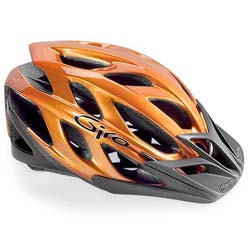
|
Giro E2 Mountain Bike Helmet
Downside: You can't afford to crash Rating: ^^^^^ (5 out of 5 peaks) Ideal User: Hot-heads, weight-weenies and fashion mavens
There's a term used for some high-end mountain bike components (as there likely is in other sports) that is "scary light." Foisted upon items including (but not limited to) handlebars, seatposts, cranks and wheels when they tip the balance between being light and being safe, "scary light" components are like a free lunch. And we all know about free lunches...
Helmets are even trickier pieces of equipment. Their manufacturers must meet strict governmental guidelines and standards for safety, yet constantly push the envelope to shave off grams and ounces - while providing as much venting as possible. Just one more vent up front can make the difference between a comfortable ride and one hot head in the summer. That's why Giro helmets are so beloved by so many cyclists and, since 1999 skiers and snowboarders who find themselves wearing the stylish lids all year round. Their cycling helmets - particularly on the high end - have so many vents and are of such light weight that one wonders how they managed to pass CPSC and CE certification. Their Pneumo road helmet, for instance, is so light and well-vented that many mountain bikers - even pros - have joined roadies like Lance Armstrong, yet wear it on the trail. The fact that it sports a visor has helped its crossover appeal. But the folks at Giro prefer you use a full-blown mountain bike helmet when off-road, and the E2 is their flagship model. Truly a sculpted work of art for your head, the E2 manages to slice through the wind while 24 strategic vents channel a breeze across your scalp even at low speeds. We suppose that a $150,000 investment in a testing technology dubbed "Therminator" helped back in '92. Even when you're barely moving, the vents do their job brilliantly, and the whole thing weighs in at just 10 ounces/284 grams. We've been riding Giro helmets for years, and have always been impressed with their styling, venting and workmanship. And this year they've upped the ante, improving the innovative Roc Loc retention system. Our previous model's side straps tended to separate from the helmet's inner foam shell, as they were held in place by double-stick hook-and-loop fasteners. But the E2's new Roc Loc 4 - which keeps the helmet secure on bumpy descents - has solved the side strap problem by embedding them right into the foam shell, while retaining all of their adjustability. Most good helmets use a retention system, but Giro's has always been one of the best. The E2 is available in several colors; our test model was a metallic orange but is also available in white, light blue and a limited-edition blue and black flame motif (which includes a hard case for $15 more). It also features a built-in "POV" visor, which snaps on and off for those days when you don't want a visor (and for easier packing). Giro covers their helmets against defects with a one-year warranty. Go to any mountain bike race and take note of who is using what helmets. You'll see plenty of brands on riders' noggins, but the name you'll likely see most often - on both cross-country and downhill riders - is Giro. Obviously they're aggressive sponsors, but you've got to figure there's another compelling reason for their popularity.
US$159.99
— Reviewed & Written by Ari Cheren, MountainZone.com Gear & News Editor
|

